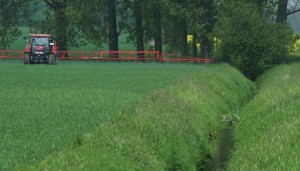In this post, Sebastian Stehle informs about their recently published paper “Agricultural insecticides threaten surface waters at the global scale”.

Pesticide application to a field bordering a surface water in Northern Germany (photo by R. Bereswill)
Global crop production increased considerably in recent decades due to agricultural intensification and expansion; at present, agricultural area occupies about 38% of Earth’s terrestrial surface – the largest use of land on the planet. However, the high-intensity agricultural practices fostered in the context of the Green Revolution such as the use of highly biologically active pesticides can threaten the ecological integrity of ecosystems worldwide. Nevertheless, our field-data based knowledge regarding the de facto exposure and effects of pesticides in non-target environments such as surface waters is very restricted.
We therefore conducted a comprehensive meta-analysis of 838 peer-reviewed studies (11,300 insecticide concentrations; >2,500 sites in 73 countries) that evaluates, for the first at the global scale, the exposure of surface waters to particularly toxic agricultural insecticides. We tested whether insecticide concentrations (MICs; i.e., quantified insecticide concentrations) exceed the official regulatory threshold levels (RTLs) defined for pesticide authorisation and how the research and development (R&D) of newer insecticide compounds influenced the risks.
Our analysis reveals that infrequent and highly transient concentration peaks characterize insecticide surface water exposure and that MICs thus occur rarely (i.e., an estimated 97.4% of analyses conducted found no MICs). Most importantly, of the 11,300 MICs actually reported, 52.4% (68.5% of the sites) exceeded the RTL. Two important conclusions can be drawn from this finding: (i) current regulatory risk assessment schemes and pesticide authorisation procedures fail to protect the aquatic environment from excessive pesticide contamination; and (ii) insecticides substantially threaten the ecological integrity of global surface waters as we clearly evidence by additional analyses on pesticide effects in the field that the regional aquatic biodiversity is reduced by approximately 30% already at pesticide concentrations equalling the RTLs. Even worse, our publication shows that there is a complete lack of scientific monitoring data for ~90% of global cropland and that both the actual insecticide contamination of surface waters and the resulting ecological risks are most likely even greater due to inadequate sampling methods employed in the studies, common occurrence of pesticide mixtures, and the occurrence of unacceptable effects already at concentrations well below the RTLs. In addition, we demonstrate based on linear model analyses that the environmental risk is even higher for newer-generation insecticides, such as pyrethroids, compared with older-generation insecticides; this finding indicates critical failures of the pesticide industries` R&D efforts to develop more environmental friendly compounds.
According to Jules Blais, the responsible PNAS Editor, this study “.. is a real eye-opener in light of the global impacts that agriculture is having on aquatic life and the natural world. It illustrates the human footprint I think a little more clearly than what we were aware of before.” We overall conclude that beside worldwide improvements to current pesticide regulations and agricultural pesticide application practices, fundamental reformations of conventional agricultural systems (e.g., by adopting promising approaches from organic farming and precision agricultural techniques) are urgently needed to meet the twin challenges of providing sufficient food for a growing human population without destroying the ecological integrity of global ecosystems essential to human existence.
The article was authored by Sebastian Stehle as well as Ralf Schulz and was published in PNAS.
